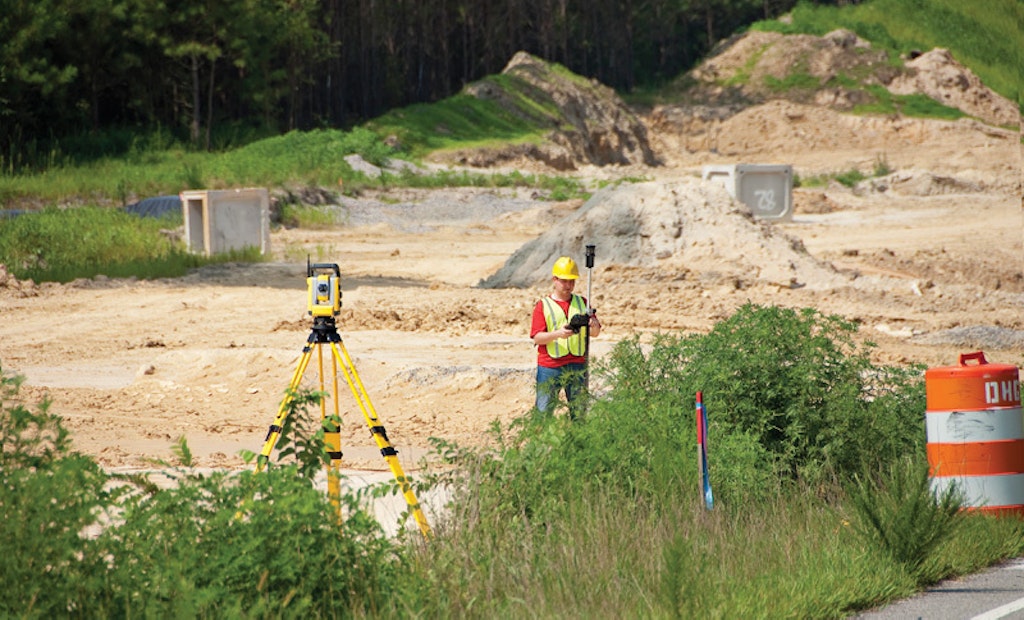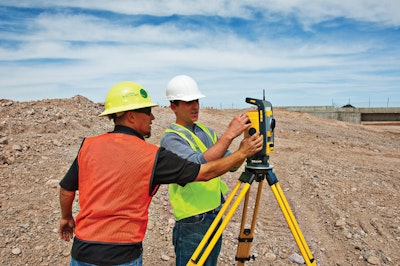
Interested in Accessories?
Get Accessories articles, news and videos right in your inbox! Sign up now.
Accessories + Get AlertsWhen prepping for work on a job site, your measurements must be precise. That means it’s important to take care of the surveying equipment charged with acquiring those accurate measurements.
“The reason you want to care for this technology is so you don’t make a mistake in positioning when you’re out on site,” says Scott Crozier, business area manager for site positioning solutions at Trimble. “You think you’ve positioned something correctly that you haven’t — that’s when it will cost you money.”
Caring for surveying equipment begins with proper storage and transport. While the equipment is designed for durability with the knowledge that it’s going to be put to work in construction environments, that’s not an excuse to treat it carelessly, Crozier says.
“I think people sometimes don’t treat the instruments with as much care as they should and typically it’s because they’re accustomed to using less precise, less expensive technology. So they treat these instruments just the same.”
Watch calibration
Total stations in particular are high-precision devices that can be easily knocked out of calibration if not handled carefully. When being stored or transported, Crozier says the instruments should always be in their carrying cases.
“They should be treated as precision devices,” he says. “Any time you knock them around or drop them, they have a chance of getting knocked out of calibration. GPS receivers, on the other hand, are more robust and don’t have the same kind of mechanical precision to them, so they don’t need quite the same level of care.”
However, the rod on a GPS receiver is something to keep an eye on.
“There’s a little bubble on the rod that tells you when the rod is level or vertical. If that gets knocked around some, it may not give you a level rod anymore, which would give you inaccurate positioning,” Crozier says.
When transporting the equipment, using the carrying case is important, as is the location where you keep the case. Crozier recommends keeping it inside the cab of a service vehicle instead of a trailer or truck bed, where the case is more likely to get jostled around.
“If you do keep it back there, make sure that carrying case is very well strapped in,” he says.
Not only can the equipment get knocked out of calibration, components could become loose and lead to future problems. “If things are loose, over time that causes wear and they could potentially bust,” Crozier says.
Stowing and going
He also recommends not storing the equipment in a humid environment and avoiding significant temperature swings.
“You want to keep the equipment at an average storage temperature within the specifications,” Crozier says. “Not too hot and not too cold. You don’t want it in an environment where it can rust or corrode due to thermal cycling. At Trimble we try to make it more resistant to corrosion, but you still have to protect these devices as much as possible.”
Another tip for preventing moisture from harming the equipment is to always make sure it is dry when returning it to the carrying case. Crozier says surveying equipment typically fits snuggly in the case with little room to spare, so putting it away wet is not a good idea.
“If it’s not dry, leave the lid open. Let the moisture out first,” he says.
In terms of regular servicing, Crozier recommends it be done annually, particularly for total stations since they are high-precision optical instruments that can be affected more by job site conditions. Even if there aren’t any clear issues with a total station’s site positioning capabilities, Crozier says regular service can prevent problems from developing.
“At a service center, they’ll go through and tune up anything that is ‘drifting off’ from the specifications and get it back to performing optimally,” he says. “If you don’t do that and it starts drifting, the wear and tear on the instrument increases over time. It’s better to bring it back so it’s in its optimal state. It’s like changing the oil in a car. You wonder if you really need to get the oil changed, but if you don’t, you run the risk of something failing that may not have failed if you were keeping up on regular oil service.”
Keeping units clean
Outside of annual service, upkeep in the field for a total station should consist of a calibration at least every two weeks, as well as ensuring positioning accuracy by checking the instrument on a known point.
“All of our software that works with these total stations has the ability to do a basic calibration on site,” Crozier says. “And whether it’s a GPS receiver or a total station, you should check it on a known control point to make sure that everything is measuring within specs. That should be done on every setup.”
For cleaning surveying tools, all you need is some soap and water. Crozier says all of Trimble’s devices are rated at IP67 so they can handle some moisture. Alcohol wipes also work well, he says. However, on total stations, contractors must be leery of what they use to clean the optic lenses.
“The lens cap should be used when the equipment is being transported and not in use,” Crozier says. “If you need to wipe the lens, you should use a specific lens-cleaning cloth. You don’t want to use anything that can scratch the lens.”
Crozier warns against attempting to make significant repairs to surveying equipment in the field. He recommends contractors call the manufacturer or reseller of the product first.
“That would be the starting point,” he says. “I wouldn’t assume anything could be fixed in the field unless I’ve been told by them. If a screw comes loose, you can tighten a screw. But typically these instruments are not designed to be repaired at the customer level. They’re precision instruments.”






